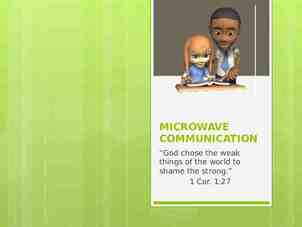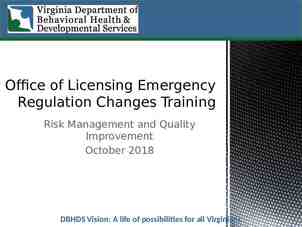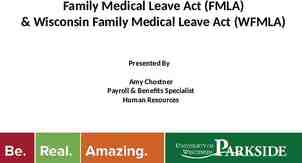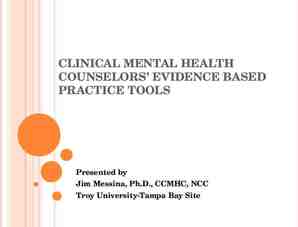News you can use Updates on IDEA Section 618 data 2019 OSEP LEADERSHIP
57 Slides2.75 MB

News you can use Updates on IDEA Section 618 data 2019 OSEP LEADERSHIP CONFERENCE 1

The Panel Moderator: Richelle Davis – US Department of Education, Office of Special Education Program, Research to Practice Division Presenters: Meredith Miceli – US Department of Education, Office of Special Education Program, Research to Practice Division Becca Smith – US Department of Education, Office of Special Education Program, Research to Practice Division Liz Fening – US Department of Education, National Center for Education Statistics, EDFacts Team Julia Redmon – AEM, EDFacts Team Beth Sinclair – AEM, EDFacts Team 2 2019 OSEP LEADERSHIP CONFERENCE

IDEA Data Quality Reviews OSEP and EDFacts 2019 Summary 2019 OSEP LEADERSHIP CONFERENCE 3

IDEA Data included in DQ Reviews 12 data collections authorized under Section 618 Part B (1) Child Count; (2) Educational Environments (3) Personnel; (4) Exiting; (5) Discipline; (6) Dispute Resolution (7) Assessment (8) Maintenance of Effort Reduction and Coordinated Early Intervening Services Part C (9) Child Count; (10) Settings (11) Exiting; (12) Dispute Resolution 4 2019 OSEP LEADERSHIP CONFERENCE

DQ Review Process 1. Define Data Checks: EDFacts works with the data stewards (OSEP) to determine DQ rules for the year 2. Complete Review at File Due Date EDFacts and program office teams prepare DQ reports Review data to identify anomalies/unexpected values (Timeliness, Completeness, Accuracy) Teams review State Submission Plan (SSP) Comments, PSC tickets, OMB Max (IDEA only), and EMAPS Assessment data (Assessment only) Program office teams may alter or remove comments based on state explanation 3. Delivery DQ Reports: Provide feedback to State in DQ reports Coordinated assessment review sent through PSC and all other IDEA DQ reports posted on OMB Max 4. States Respond: Data providers resubmit or provide detailed data notes 5. Final Review: After final due date, review data and assesses quality that informs internal data use, final public file production and public data notes document 5 2019 OSEP LEADERSHIP CONFERENCE

IDEA Business Rules All IDEA Business Rules are published in the Business Rules Single Inventory (BRSI) on the EDFacts Initiative website including: ESS business rules Post-Submission DQ rules 6 2019 OSEP LEADERSHIP CONFERENCE

State Notes Thank you for providing very thoughtful responses and feedback to the last round of outreach! 2019 OSEP LEADERSHIP CONFERENCE

Annual IDEA DQ Review Calendar January February March April IDEA Discipline, Exiting, Personnel May June IDEA Child Count July August IDEA MOE/CEIS IDEA Assessment *DQ blocks above indicate when DQ feedback is sent out to data providers to resubmit and/or provide state data notes 8 2019 OSEP LEADERSHIP CONFERENCE

IDEA DQ Results Summary Summary of results and most prevalent issues Discipline, Exiting, Personnel (November collections) Assessment Child Count MOE/CEIS 9 2019 OSEP LEADERSHIP CONFERENCE

Feedback On report format, delivery, etc 2019 OSEP LEADERSHIP CONFERENCE 10

EDFacts Reporting System (ERS) Reports ERS prefill reports status Reports are being discontinued A replacement Potentially, IDEA Part B data managers can run a data extract through EMAPS 11 2019 OSEP LEADERSHIP CONFERENCE

IDEA Part B ESS Data Reports Proposed data extracts to replace retired ERS IDEA reports 12 2019 OSEP LEADERSHIP CONFERENCE

IDEA Part B ESS Data Reports The user would be prompted to select a school year and one of five IDEA Part B collections: Assessment Child Count Discipline Exiting Personnel 13 2019 OSEP LEADERSHIP CONFERENCE

IDEA Part B ESS Data Reports The system would generate an Excel data extract for the selected school year and collection, and put it in an IDEA Part B reports folder 14 2019 OSEP LEADERSHIP CONFERENCE

IDEA Part B ESS Data Reports Sample Data Extract: 15 2019 OSEP LEADERSHIP CONFERENCE

IDEA Section 618 Data Collection & Reporting Current IDEA Section 618 Data Quality Work: LEA Level Part B Child Count 2019 OSEP LEADERSHIP CONFERENCE 16

LEA Data Quality Review Shifting review to OSEP and IDEA data managers in Summer 2020 Practice review starting in late July/early August 2019 Webinar coming soon Will spend the coming year helping States prepare Review will mimic SEA review and address: Timeliness Accuracy Completeness 2019 OSEP LEADERSHIP CONFERENCE

IDEA Section 618 Data Collection & Reporting Upcoming Changes to the IDEA Section 618 Part B Data Collections 2019 OSEP LEADERSHIP CONFERENCE 18

Part B Child Count and Educational Environments – FS002 & 089 Report 5 year old children with disabilities who are in kindergarten in the School Age data file (FS002) Continue to report 5 year old children with disabilities who are in preschool in the Preschool data file (FS089) OSEP will provide flexible for a 1-year transition period Reporting the 5 year old kindergartners in FS002 will be: optional for the 2019 Part B Child Count and Educational Environments data (due April 1, 2020). Required for the 2020 Part B child Count and Educational Environments data (due April 7, 2021) Please provide a data note if your states continues reporting 5 year old kindergarteners in FS089 for the 2019 Part B Child Count and Educational Environments data collection (due April 1, 2020). 19 2019 OSEP LEADERSHIP CONFERENCE

Part B IDEA Personnel Data – FS070 & 112 Report staff employed or contracted to provide services to 5 year old children with disabilities who are in kindergarten with in the “6-21”/ school age group. Clarification will be provided in the file specifications for FS070 and FS 112 OSEP will provide flexible for a 1-year transition period for states to implement this change 20 2019 OSEP LEADERSHIP CONFERENCE

Part B IDEA Assessment Data – FS 175 & 178 Assessment performance counts will be reported by “proficient” & “not proficient”, instead of by individual performance levels. States are expected to report in this way for the 2019-20 Assessment data, due December 2020. 21 2019 OSEP LEADERSHIP CONFERENCE

IDEA Section 618 Data Collection & Reporting MOE Reduction & CEIS Data Collection 2019 OSEP LEADERSHIP CONFERENCE 22

Reminders about MOE and CEIS Data Report the amounts that were reserved for CEIS instead of the funds expended Only report the amount of local and/or State funds that were reduced pursuant to Section 613(a)(2) (C). Please use the LEA/ ESA update flags as appropriate: 23 1 – LEA/ESA Name Change 2 – Remove LEA/ESA from report 3 – LEA/ESA added to report 5 – NCES ID Change 6 – Closed LEA/ESA with Data (NEW in the last submission!) 2019 OSEP LEADERSHIP CONFERENCE

Reminders about MOE and CEIS Data Reporting on the LEA/ ESA meeting the MOE compliance standard and returning funds to the Department: B5 – only report NA if: LEA/ESAs with Update Flag 3 (new) or Your state/entity is a unitary system or BIE If B5 No or NA, then B6, B7, and B8 NA If B6 Yes or NA, then B7 & B8 NA If B7 No or NA, then B8 NA 24 2019 OSEP LEADERSHIP CONFERENCE

Reminders about MOE and CEIS Data B7: By the date of this data submission, did the State return nonFederal funds to the Department based on the failure of the LEA/ESA to meet the MOE compliance standard in the reference year? B8: What amount of non-Federal funds did the State return to the Department based on the failure of the LEA/ESA to meet the MOE compliance standard in the reference year? Report funds that have been returned as of the date of the data submission. 25 2019 OSEP LEADERSHIP CONFERENCE

Clarifications related to MOE and CEIS Data Only report on Federal IDEA funds when reporting the amount of funds reserved for and the number of children who received CEIS Only report the amount of funds reserved for CEIS for the reporting year – do not include any funds that were carried over for CEIS from the previous year 26 2019 OSEP LEADERSHIP CONFERENCE

Upcoming Change to MOE and CEIS Data Review If NA was reported for the previous year’s 611 allocations (A2A) AND/ OR If NA was reported for the LEA determination (B2) AND An update flag of 3 (to indicate a new LEA/ ESA) is reported THEN No comment will be sent back to the state 27 2019 OSEP LEADERSHIP CONFERENCE

IDEA Section 618 Data Collection & Reporting Part C Data Collections 2019 OSEP LEADERSHIP CONFERENCE 28

Part C Corner Another great year of reporting! Part C Exiting- 12 month reporting periods Reaction to the new EMAPS platform 29 2019 OSEP LEADERSHIP CONFERENCE

Technical Assistance on IDEA Data 2019 OSEP LEADERSHIP CONFERENCE 30

Update on 373 TA Status for currently funded centers IDC DaSy CIID CIFR Future funding 31 2019 OSEP LEADERSHIP CONFERENCE

Data Use & Analysis 2019 OSEP LEADERSHIP CONFERENCE 32

Why Is Data Analysis and Use Important? “Most of the world will make decisions by either guessing or using their gut. They will be either lucky or wrong.” -Suhail Doshi, CEO, Mixpanel 33 2019 OSEP LEADERSHIP CONFERENCE

How is OSEP using IDEA data? Policy Decisions Grant Priorities Monitoring Results Driven Accountability Determinations If you can’t measure it, you can’t improve it. - Peter Drucker 34 2019 OSEP LEADERSHIP CONFERENCE

Who is represented in IDEA Data? 388 thousand Part C infants and toddlers 773 thousand Part B students ages 3-5 6.1 million Part B students ages 6-21 4.9 thousand Special Education Paraprofessionals 5.2 thousand Special Education Teachers Data Source: IDEA Public Release Files: Personnel 2016-17, B Child Count and Ed Environments 2017-18, C Child Count and Settings Single Day Count 2017-18 https://www2.ed.gov/programs/osepidea/618-data/ 35 2019 OSEP LEADERSHIP CONFERENCE

Child Count 36 2019 OSEP LEADERSHIP CONFERENCE

C Child Count Trends – US and Outlying Areas 16.5% 37 2019 OSEP LEADERSHIP CONFERENCE

B Child Count Trends – US and Outlying Areas 38 2019 OSEP LEADERSHIP CONFERENCE

There is wide variation in the number of students served in each State California New York Texas Florida 2019 OSEP LEADERSHIP CONFERENCE

Disability categories 2019 OSEP LEADERSHIP CONFERENCE

Thirteen disability categories under IDEA Specific learning disability 38.2% Speech or language impairment 16.6% Other health impairment 15.8% Autism 10.1% Intellectual disability 6.8% Emotional disturbance 5.5% Developmental delay 2.6% Multiple disabilities Hearing impairment 2.0% 1.1% Orthopedic impairment 0.6% Traumatic brain injury 0.4% Visual impairment 0.4% Deaf-blindness 0.02% B Child Count, 2017-18 ,US Freely Associated States, and Outlying Areas totals 2019 OSEP LEADERSHIP CONFERENCE

Frequency of disability categories is changing 3M 2M 500K a br c 500K ati m u a Tr in ry ju in ta en pm lo e v De ay el d l le tip l u M B Child Count 2008-2017 es liti i b sa di m tis u A he Ot th al e rh pa im t en m ir e Sp ea cl ic fi te In g in rn c lle a tu y lit bi a s di lD /M iil ty b isa t en r al a et ati rd h ec e Sp on g ua g lan or e pa im t en m ir a on ti o Em ce an b ur st i ld Or pa m i ic ed p o th t en m ir He g in ar pa im t en m ir a su Vi pa il m t en m ir De a ss ne d lin f-b 2019 OSEP LEADERSHIP CONFERENCE

Educational environment 2019 OSEP LEADERSHIP CONFERENCE

Students are more likely to be spending 80% or more of the day inside regular classes 2019 OSEP LEADERSHIP CONFERENCE

Students are slightly less likely to spend between 40 and 79% of the day in regular classes 2019 OSEP LEADERSHIP CONFERENCE

Students are less likely to spend 40% or less of the day in regular classes 2019 OSEP LEADERSHIP CONFERENCE

Part B exiting 2019 OSEP LEADERSHIP CONFERENCE

More students are exiting school with a regular high school diploma 80% 70% 60% 50% 40% 30% 20% 10% 0% Died Dropped out 2007-2008 2008-2009 2009-2010 Graduated with regular high school diploma 2010-2011 2011-2012 2012-2013 Reached maximum age 2013-2014 2014-2015 2015-2016 Received a certificate 2016-2017 2019 OSEP LEADERSHIP CONFERENCE

Regular high school diploma rates increasing across most disability categories 2019 OSEP LEADERSHIP CONFERENCE

Certificate rates declining slightly 2019 OSEP LEADERSHIP CONFERENCE

Drop out rates declining slightly 2019 OSEP LEADERSHIP CONFERENCE

Part C exiting 2019 OSEP LEADERSHIP CONFERENCE

Percent of Part C Exiters by Exiting Category 40% 35% 30% 25% 20% 15% 10% 5% 0% Attempts to Completion contact of IFSP prior unsuccessful to max age 2010-2011 53 Deceased Moved out Not eligible of state Part B - exit to other program 2011-2012 2012-2013 Not eligible Part B Part B - exit eligibility not with no determined referrals 2013-2014 2014-2015 Part B eligible continuing in Part C 2015-2016 Part B Withdrawal eligible/ Part by parent B eligible exiting Part C 2016-2017 2019 OSEP LEADERSHIP CONFERENCE

There is wide variation between States in C exiting categories Percent of Children Exiting Part C by Year and Category, US and Outlying Areas 2008-2009 45% 40% 35% 30% 25% 20% 15% 10% 5% 0% Attempts to contact unsuccessful Completion of IFSP prior to max age Deceased 2009-2010 2010-2011 Moved out of state 2011-2012 2012-2013 2013-2014 Not eligible Part B Not eligible Part B exit to other program exit with no referrals 2014-2015 2015-2016 Part B eligibility not determined 2016-2017 Part B eligible continuing in Part C Part B eligible/ Part B Withdrawal by parent eligible exiting Part C 2019 OSEP LEADERSHIP CONFERENCE

Thank You 55 IDEA data have a direct impact on improving the lives of children with disabilities. “Things get done only if the data we gather can inform and inspire those in a position to make [a] difference.” We continue to rely on you and are grateful for the valid, reliable data you provide each year. – Mike Schmoker, former school administrator, English teacher and football coach, author. 2019 OSEP LEADERSHIP CONFERENCE

Converse with the Crew 2019 OSEP LEADERSHIP CONFERENCE 56

OSEP Disclaimer 2019 OSEP Leadership Conference DISCLAIMER: The contents of this presentation were developed by the presenters for the 2019 OSEP Leadership Conference. However, these contents do not necessarily represent the policy of the Department of Education, and you should not assume endorsement by the Federal Government. (Authority: 20 U.S.C. 1221e-3 and 3474)






